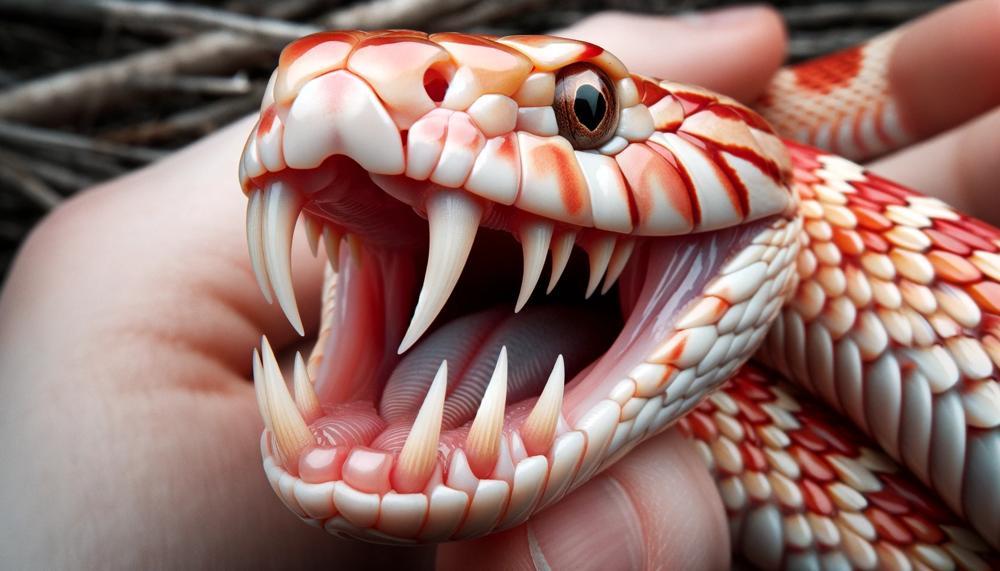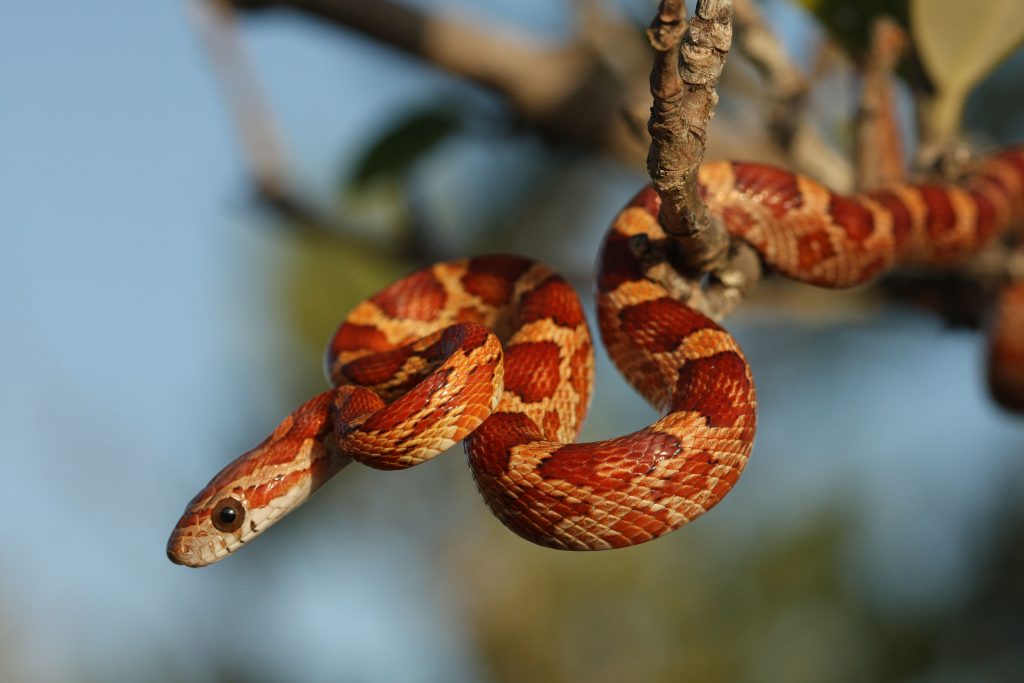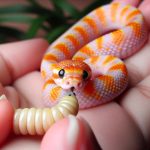Today, we embark on a journey into the intriguing world of corn snakes and their teeth. While these slithery creatures may not strike fear into our hearts like venomous snakes do, they possess a unique set of teeth that are vital to their survival. So, do corn snakes have teeth?
Yes, corn snakes have teeth, but they don’t have fangs. Corn snakes have many sharp-pointed teeth, similar to a tiny mitten lined with needles. Corn snakes use their teeth to grab their prey before swallowing it whole. Snakes shed their teeth constantly, replacing the oldest teeth with new sharp teeth.
But why should we care about the minute details of corn snake teeth? Well, my friends, these seemingly insignificant structures play a crucial role in the success of this beloved species. So let’s slither deeper into this topic and discover the importance of corn snake teeth.
Contents
- 1 Do Corn Snakes Have Teeth or Fangs?
- 2 What Do Corn Snake Teeth Look Like?
- 3 Why Are Corn Snake Teeth Angled Backwards?
- 4 How Do Corn Snake’s Teeth Trap the Prey?
- 5 How Aggressive Are Corn Snakes?
- 6 Are Corn Snakes Poisonous?
- 7 Can My Pet Corn Snake Kill a House Cat?
- 8 How Can I Prevent Corn Snake Bites?
- 9 Conclusion
Do Corn Snakes Have Teeth or Fangs?
Snakes use their mouth structures to capture and consume prey, with two main types being teeth and fangs. While both serve the same purpose, there are distinct differences between the two.
| Teeth | Fangs |
| Small and thin in size | Long and hollow in shape |
| Jagged and angled backwards | Sharp and curved inwards |
| Used for gripping and holding prey in place while swallowing it whole | Used to inject venom into prey for immobilization and digestion |
| Found in both upper and lower jaw, with more teeth on the upper jaw than the lower | Found only in the upper jaw, with one or two fangs on each side |
| Corn snakes have teeth instead of fangs as they are non-venomous and do not need to inject venom into their prey. | Corn snakes do not have fangs, as they are non-venomous and do not need to inject venom into their prey. |
Corn snakes, belonging to the Colubridae family of non-venomous species, have teeth instead of fangs. Their small, thin teeth are jagged and angled backwards, allowing them to grip and hold onto prey while they constrict it with their powerful muscles. These teeth are evenly spaced in both the upper and lower jaw, with a slightly higher number on the upper jaw.
Corn snakes can also grow new teeth to replace broken ones, ensuring they always have a full set for hunting.
What Do Corn Snake Teeth Look Like?
Corn snakes possess around 20-30 teeth, with a higher number on their upper jaw compared to the lower. These teeth have a sharp and serrated appearance, similar to that of a wood saw, and are primarily used for gripping and holding onto their prey during hunting. Unlike venomous snakes, corn snakes lack fangs as they do not need them for hunting or self-defense.
Moreover, these small and jagged teeth play a crucial role in the digestion process of corn snakes. They help break down food into smaller pieces, making it easier for them to digest. In the rare instance of a person being bitten by a corn snake, they may feel a slight pinprick sensation and may experience tiny blood spots due to the sharpness of the teeth. However, corn snakes are typically docile creatures and will only bite if provoked.
It is important to note that while corn snakes can coexist with each other, they should be monitored for any aggressive behavior towards one another. This is especially true during feeding time when snakes may become territorial over food.
Overall, the teeth of corn snakes are a vital aspect of their anatomy and play a crucial role in their survival and thriving in their natural habitat.
| Number of Teeth | Location | Description |
|---|---|---|
| Around 20-30 | Upper and lower jaw | Small, sharp teeth used for gripping and holding onto prey |
| More on upper jaw than lower jaw | Upper and lower jaw | Corn snakes have a higher number of teeth on their upper jaw compared to the lower jaw |
| No presence of fangs | N/A | Corn snakes do not possess fangs like venomous snakes |
In conclusion, corn snakes have approximately 20-30 small and sharp teeth that are essential for gripping and holding onto prey, as well as aiding in the digestion process. These teeth resemble that of a wood saw and do not include fangs like venomous snakes.
Why Are Corn Snake Teeth Angled Backwards?
Corn snakes possess uniquely angled back teeth that serve a crucial purpose in their predatory tactics. These specially designed teeth not only aid in grasping and securing prey, but also play a vital role in the snake’s ability to efficiently consume its food, ultimately ensuring its survival.
The reason for this unique adaptation can be traced back to the snake’s natural habitat and feeding habits. In the wild, corn snakes primarily feed on small rodents, such as mice and rats. These creatures are known for their quick movements and tendency to struggle when caught, making them a challenging meal for any predator.
To overcome this challenge, corn snakes have evolved with backward-angled teeth that are perfectly suited for gripping and holding onto their prey while they constrict. This allows the snake to maintain a tight hold on its prey, preventing it from escaping and making it easier to consume.
But how exactly do these teeth work? The angled shape of the teeth creates a sort of “hook” that catches onto the fur or skin of the prey, providing a secure grip. This is especially helpful when dealing with larger prey that may put up a stronger fight.
Additionally, these angled teeth also help the snake to tear apart its food into smaller, more manageable pieces. This is crucial for digestion as snakes do not have the ability to chew their food like other animals. By breaking down their meals into smaller chunks, corn snakes can more easily swallow and digest their food.
How Do Corn Snake’s Teeth Trap the Prey?
The teeth of corn snakes are specifically designed to capture and maintain a firm hold on their prey. With jagged and angled structures, these teeth act as hooks that allow the snakes to securely grip onto their prey while they constrict it. This unique feature also aids in tearing apart the food into smaller pieces for easier digestion.
Let’s take a closer look at how the teeth of corn snakes function to capture and hold onto their prey:
Jagged and angled structure
Corn snakes have approximately 20-30 teeth, with more on their top jaw than the bottom. These teeth have jagged edges and are angled backwards, providing a strong grip on their prey without easily letting go.
This is especially crucial when hunting fast-moving prey like rodents or birds.
No venomous fangs
Unlike venomous snakes, corn snakes do not have fangs. Instead, their teeth are small and non-threatening, with no venom glands.
This makes them a popular choice as pets, as their bites are usually just small pinpricks that do not pierce the skin.
Aiding in digestion
The teeth of corn snakes serve another important purpose – pushing food down into their digestive system.
As they swallow their prey whole, their teeth help prevent regurgitation by keeping the food in place.
Firm grip on prey
Corn snakes use their teeth to hold onto their prey while they constrict it. This allows them to subdue larger or stronger prey without fear of losing their grip. The strong and secure grip provided by their teeth is crucial for their survival.
How Aggressive Are Corn Snakes?
When it comes to corn snakes, aggressive behavior is not typically directed towards humans or other animals. However, there are certain situations where they may display aggressive behaviors, such as defensive postures like coiling and hissing, and even striking if they feel threatened.
Nevertheless, these behaviors are usually a last resort and can be avoided with proper handling and care.
| Behavior | Description | How to Handle |
| Defensive Posturing | When feeling threatened, corn snakes may coil up, hiss, and even shake their tails (which may produce a rattling sound). | To handle this behavior, remain calm and avoid making sudden movements. Give the snake enough space and time to calm down before attempting to handle it again. |
| Striking | If a corn snake feels extremely threatened, it may strike out in an attempt to defend itself. | To handle this behavior, wear protective gloves and use a snake hook or other tool to gently move the snake away from you. It is important not to try to handle the snake until it has calmed down. |
| Tail Vibrations | Corn snakes may also vibrate their tails when feeling threatened, which can be mistaken for a rattlesnake’s warning signal. | Be aware of the difference between tail vibrations and rattling sounds. If in doubt, always err on the side of caution and give the snake enough space. |
| Biting | In rare cases, corn snakes may bite if they feel extremely threatened or are in pain. This is usually a last resort defense mechanism. | If bitten, remain calm and seek medical attention if necessary. Corn snake bites are usually not serious and rarely require medical intervention. |
While there are instances where corn snakes may exhibit aggressive behavior, it is important to note that they are generally docile and non-aggressive creatures. Proper handling, care, and respecting their natural instincts can help prevent any potential aggressive behaviors.
Are Corn Snakes Poisonous?
Corn snakes are non-venomous and their bites are not poisonous, making them relatively harmless. Unlike other snakes, they do not have fangs, so their bites do not contain any venom. With proper precautions, handling a corn snake is typically safe. However, it is important to remember that all snakes have teeth and may still inflict a bite if provoked.
While corn snakes may not be dangerous in terms of venom, there are still risks associated with handling them. As with any animal, proper handling techniques should be followed to avoid injury to both the handler and the snake. It is important to approach a corn snake calmly and confidently, avoiding sudden movements or loud noises that could startle the snake.
Additionally, it is important to wash your hands before and after handling a corn snake. This helps prevent the spread of any bacteria or parasites that may be present on the snake’s skin. It is also recommended to handle a corn snake over a soft surface, such as a carpet or towel, to prevent any falls or injuries.
As with all reptiles, corn snakes have specific care requirements that must be met for them to thrive in captivity. These include providing proper heat and humidity levels, offering a varied diet, and ensuring a clean and spacious enclosure. It is important to research and understand these requirements before bringing a corn snake into your home.
Can My Pet Corn Snake Kill a House Cat?
It is possible to keep a pet corn snake in a household with a house cat, but it is not advisable. Cats, being natural predators, may view the corn snake as prey and potentially harm or even kill it. Additionally, corn snakes have specific care and handling requirements that may not be suitable for a household with a cat.
Unlike other pets like dogs or cats, corn snakes are not affectionate animals and do not require as much attention. They are solitary creatures and do not seek out human interaction. This can lead to misunderstandings between the snake and the cat, potentially resulting in harm for both animals.
Moreover, the diet of a corn snake may also be problematic in a household with a cat. Corn snakes are strict carnivores and primarily eat small rodents like mice and rats. Similarly, cats are meat-eaters, and they may see the snake’s food as an easy meal. This can lead to aggressive behavior from the cat towards the snake or competition for food.
How Can I Prevent Corn Snake Bites?

When it comes to avoiding corn snake bites, there are a few key strategies that can be highly effective. One important aspect is handling these reptiles with great care, as they can easily become agitated and potentially strike.
It’s also crucial to provide a suitable enclosure for your corn snake, as a cramped or inadequate habitat can cause stress and lead to aggressive behavior. Additionally, being aware of their stress signals is crucial for preventing bites.
These can include hissing, flattening of the body, or shaking the tail rapidly. If you notice any of these signs, it’s best to give your snake some space and seek professional help if needed.
Conclusion
In summary, while corn snakes may not possess the intimidating fangs of venomous snakes, their teeth are just as vital for their survival.
These tiny yet sharp teeth are angled backwards, allowing them to securely grasp onto prey while constricting. With up to 30 teeth at a time and the ability to regenerate new ones, these snakes rely on their teeth to capture and consume food.
Furthermore, it is not advisable to keep them in households with cats due to potential risks for both animals.






